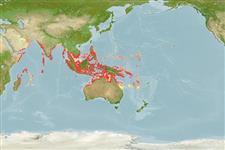Classification / Names
Common names from other countries
Main reference
Size / Weight / Age
Max length : 22.0 cm SL male/unsexed; (Ref. 54980); common length : 14.0 cm SL male/unsexed; (Ref. 3107)
Environment
Marine; freshwater; brackish; pelagic-neritic; anadromous (Ref. 51243); depth range 0 - 50 m (Ref. 188)
Climate / Range
Tropical, preferred 28°C (Ref. 107945); 31°N - 23°S, 47°E - 171°E (Ref. 188)
Distribution
Indo-West Pacific: Persian Gulf to coasts of India and Andaman Sea, to Gulf of Thailand, Indonesia, Viet Nam, and Philippines, south to northern Australia, the Caroline Islands and New Caledonia.
Countries | FAO areas | Ecosystems | Occurrences | Introductions
Short description
Dorsal
spines
(total): 0;
Anal
spines: 0;
Anal
soft rays: 17 - 25. Body depth increasing with size of fish, 40 to 70 % standard length in fishes over 10 cm. Second supra-maxilla a mere splint. Longest gill rakers on lower part of arch less than corresponding gill filaments. Hind edges of scales toothed, the teeth thinner than the gaps between them; a median series of pre-dorsal scales. A large black spot behind gill opening.
IUCN Red List Status (Ref. 115185)
Threat to humans
Harmless
Human uses
Fisheries: commercial
More information
ReferencesAquacultureAquaculture profileStrainsGeneticsAllele frequenciesHeritabilityDiseasesProcessingMass conversion
Tools
Special reports
Download XML
Internet sources
Estimates of some properties based on models
Phylogenetic diversity index
PD50 = 0.6250 many relatives (e.g. carps) 0.5 - 2.0 few relatives (e.g. lungfishes)
Trophic Level
2.8 ±0.28 se; Based on food items.
Resilience
High, minimum population doubling time less than 15 months (K=0.9-1.3)
Vulnerability
Low vulnerability (14 of 100)
Price category
